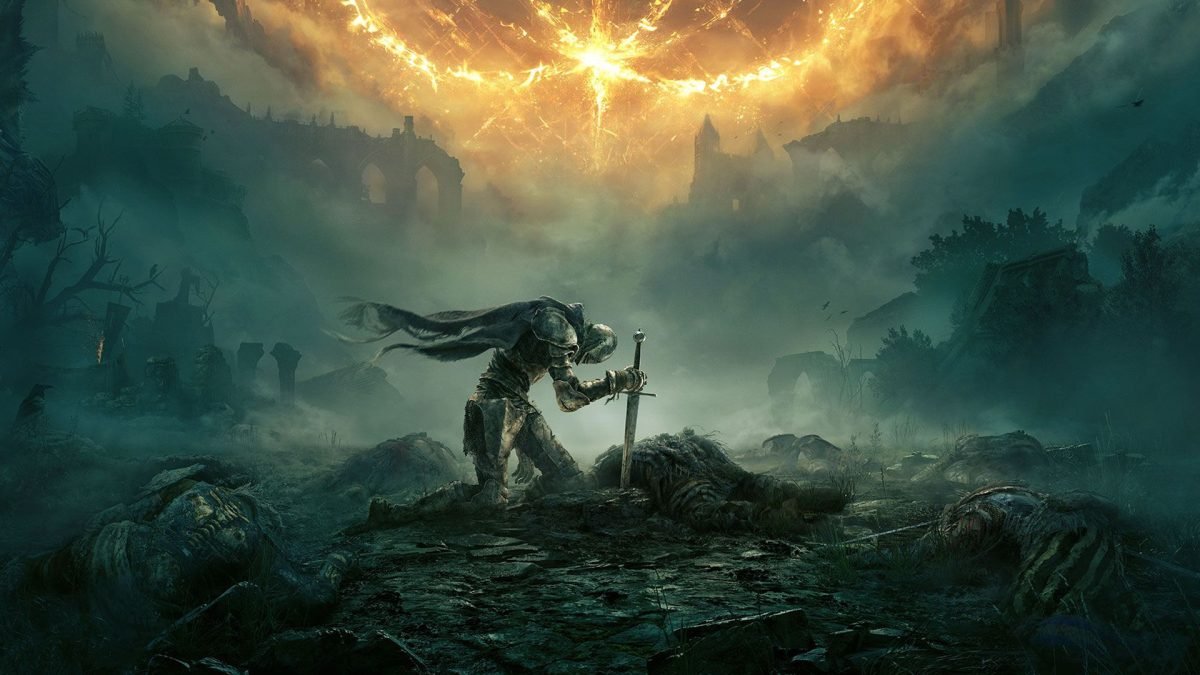Elden Ring is a saga penned by George R. R. Martin and Hidetaka Miyazaki. One that slowly expands to reveal new mysteries, conquests, and people over the course of its many, many hours. At times, the pacing is glacial, as progress feels marginal, and your abilities evolve in fits and starts as opposed to the steady rhythm found in previous FromSoftware games. Yet the world itself never loses its sense of wonder, and so too did I never lose my sense of wanderlust. I want to continue to explore its plateaus, forests, and rotting wastelands. Because with each new face, enemy, and monument I encounter, Elden Ring reminds me that the journey is far more important than the destination.
Elden Ring is, quite simply, mesmerizing.
Like the Souls franchise and other games developed by FromSoftware, there is a basic structure to be found in Elden Ring that will be familiar to anyone who has played these RPGs before. The world, known here as the Lands Between, has been shattered following a cataclysmic event, in this case the destruction of the titular Elden Ring. The pieces of it have taken the form of Great Runes, which have in turn corrupted the demigods who now rule over parts of the realm. As a Tarnished, your duty is to venture into the Lands Between to reforge the Elden Ring and become the Elden Lord. To do that, you will make use of countless weapons, abilities, magical spells, and tools to survive in harrowing combat against various monstrosities. And like other Souls games, one can assume this will be difficult.
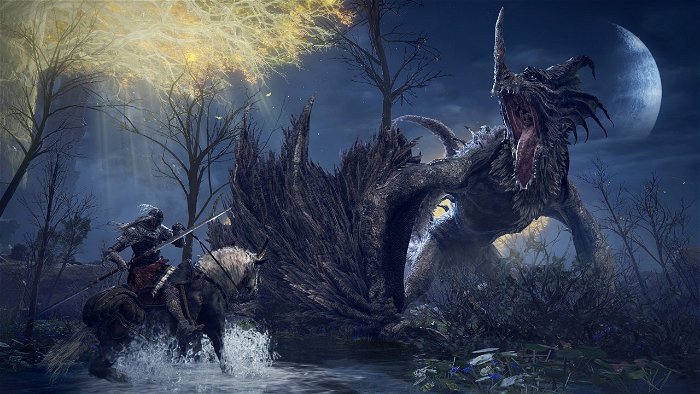
While the trappings are familiar, there is one major change: the world design. For the first time in the Souls franchise, Elden Ring features an open world. And how open it is — the Lands Between feel enormous, crammed with ruins and forests and cliffs and monstrosities and encampments and dungeons and secrets and a host of other things to discover. In truth, it is likely far smaller than my mind is imagining it to be. But unlike so many other open world games, particularly of the AAA variety, Elden Ring doesn’t feel stuffed with things to do for the sake of there being things to do.
Rather, the world is designed in such a way that I felt like I was discovering and manoeuvring through it on my own terms as opposed to following the structure of the game itself. Granted, there is a guidance system on the map — which Elden Ring has, speaking of — that points you in the direction of where you need to go to complete the overarching plot of reforging the Elden Ring. But beelining for the goals on the map would result in an unsatisfying experience, in my opinion. The natural moments where you stumble across a new side quest or location on your own lead to more memorable experiences.
Take, for example, a village I uncovered situated beneath a cavern atop a poisonous swamp. The villagers had been afflicted by some plague or condition that resulted in them being unable to walk. They were a poor lot to put down, but in the course of exploring the dying village, I found an elderly man who implored me to take half of a medallion and find another survivor of the village located somewhere in the world. The complete medallion would serve as a key to a Great Lift, but I had no knowledge or idea as to where the survivor was located.
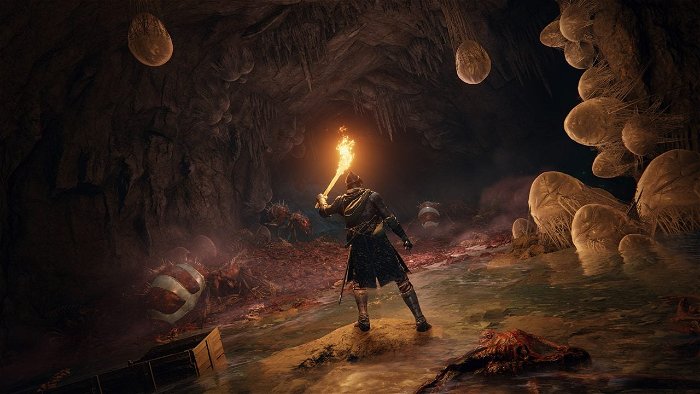
It was some ten hours or so later when I found that survivor on a cliffside after crawling through a crystalline dungeon. They were friendly after I showed them the medallion half, and they asked to join me so that we could recover the other half from some murderer located at the top of a mountain on the other side of the map. This quest isn’t tracked on the map, nor is there a guidance system for me to follow to complete it. I only have my notes, a general overview of what I must do, and the will to follow through with it. This entire quest is but one of several that I’ve uncovered in my time with Elden Ring, and each is as mysterious as it is captivating.
“Elden Ring is a saga, one filled with glory and struggles…”
Not that every aspect of the world is new and exciting. It will not take long to realize that many of the smaller dungeons, found embedded in cliffs or ruins, follow similar patterns in terms of design. If you see cobblestone, chances are the dungeon will have small moss-covered stone imps as enemies. Perhaps it will even have the same cat statue as a boss, as I have fought it three separate times with minor variations differentiating each instance.
The rewards for completing these dungeons can be a simple item, or it can open a path to an island where you are able to sacrifice dragon hearts for draconic powers: you’ll never know until you dive into them. And while I understand that not every encounter can be unique in Elden Ring, I can’t help but be disappointed and annoyed whenever I see that cat statue boss.
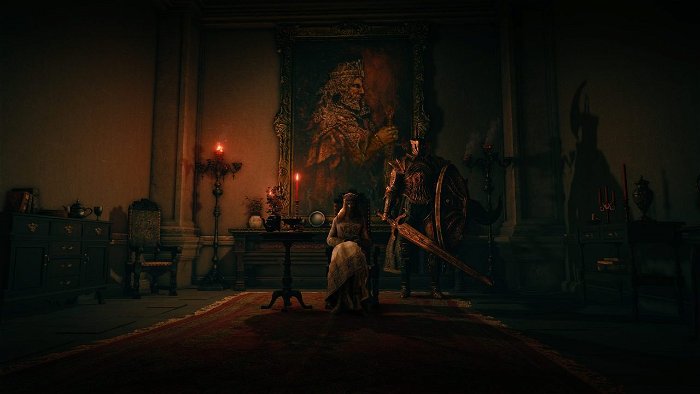
In comparison, the larger dungeons that make up the residences of Elden Ring’s major bosses and demigods are a treat. They are classic Souls levels, filled with shortcuts, secrets, and enemies that make exploring them tense experiences. These castles, academies, and cities are massive, and their scale makes you feel very small even in a world that is as vast and large as the one outside these locales walls. And the boss fights in these locations are sublime, even by the standards of FromSoftware.
Yet in comparison to other Souls games, the world design also affects the mechanics in one very important way: running away is now an important tool to use. You could turn tail in previous Souls games to rest and recuperate, but looking back on it, the ability to run away was hindered by the tightness of the levels themselves.
Here, you can hop on your steed (named Torrent) and ride off into another direction to escape enemies or to reconsider your approach. With the additional inclusion of stealth, running away becomes an offensive tool that can dramatically influence the outcome of a battle. And if you find yourself dying to the same enemy again and again, it is easy to run away and find a new challenge to tackle while you slowly grow stronger.
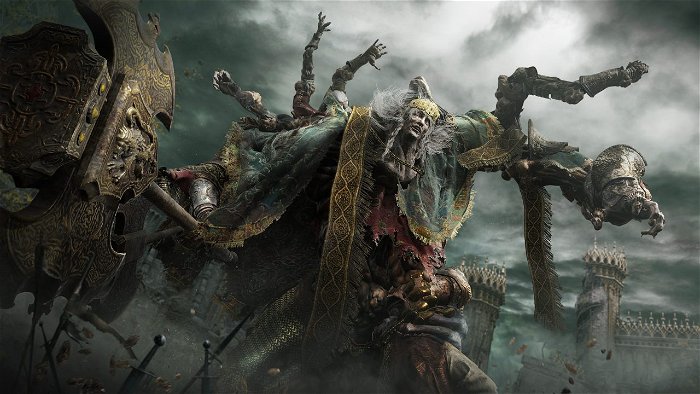
Even if you do die, there is barely any punishment for it in Elden Ring. You will lose your experience (runes as they are called in game), which can be picked up at the location of your death, but beyond that, dying is a minor inconvenience due to the ubiquitous respawn points outside the colossal dungeons. You can fast travel from any point, runes are easy to acquire, and wasted resources can be recovered without much effort. Coupled with the new gameplay additions, such as the ability to interchange weapon arts and summonable spirits that can provide backup should you have the magic to cast it, and there are plenty of tools at your disposal. There is always something new to tackle in Elden Ring, and I can say that the nature of the world design means that it is arguably the most accessible in the FromSoftware RPG catalogue.
“There is always something new to tackle in Elden Ring…”
This extends into smaller changes as well. Crafting means you can acquire all the resources you need to construct bombs, salves, weapon coats, and arrows with relative ease by picking up materials from the environment — for example, I have killed hundreds upon hundreds of deer for materials to make bone arrows. The user interface is cleaner, with weapons being separated by type and onscreen prompts providing clearer explanations for status effects and mechanics. I genuinely cheered when I saw that the status screen now states what your equipment load is, meaning I no longer have to do calculations in my head to see if I can do a fast roll.
All of these changes — to the world, to the gameplay, to the user interface — are important, and facilitate that sense of discovery that makes me want to spend as much time in the Lands Between as possible. Because I look at what FromSoftware has made, and I think of the experiences I’ve stumbled into exploring its vast world.
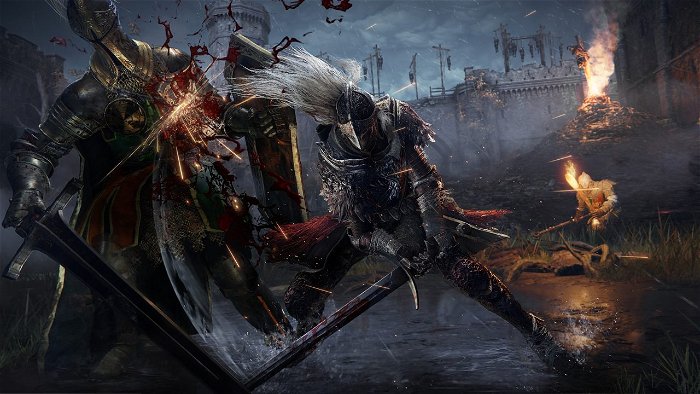
I think of charging headlong into a dragon as it rears back to launch magical missiles at me amidst the ruins on a lakebed, knowing that one hit will knock me off of my horse.
I think of teleporting halfway across the map because I opened a chest that was booby trapped, struggling to make my way back to safer locations while wandering across a blood-red wasteland.
And I think of seeing the commander of a fort grieving over the body of his child as he vows vengeance against the parties responsible, wondering where I will find him next.
Elden Ring is a saga, one filled with glory and struggles, conquests and mystery, and failures and victories. It’s a journey that feels personal, and is one that I don’t think will be experienced in an identical way by anyone else who plays it. It’s an adventure, a triumph for FromSoftware, and most importantly, a game that should be played.
